Marketing Environment is the combination of external and internal factors and forces that affect the company’s ability to establish a relationship and serve its customers. There are two kinds of external marketing environments– micro and macro. These environmental factors are beyond the control of marketers but they still influence the decisions made when creating a strategic marketing strategy.
Micro Environment Factors
The micro-component of the external environment is also known as the task environment. It comprises of external forces and factors that are directly related to the business.
- Suppliers: Suppliers can control the success of the business when they hold power. The supplier holds the power when they are the only or the largest supplier of their goods; the buyer is not vital to the supplier’s business; the supplier’s product is a core part of the buyer’s finished product and business.
- The resellers: If the product the organization produces is taken to market by 3rd party resellers or market intermediaries such as retailers, wholesalers, etc. then the marketing success is impacted by those 3rd party resellers. For example, if a retail seller is a reputable name then this reputation can be leveraged in the marketing of the product.
- The customers: Who the customers are (B2B or B2C, local or international, etc.), and their reasons for buying the product will play a large role in how you approach the marketing of your products and services to them.
- The competition: Those who sell the same or similar products and services as your organization is your market competition, and the way they sell needs to be taken into account. How does their price and product differentiation impact you? How can you leverage this to reap better results and get ahead of them?
- The general public: Your organization has a duty to satisfy the public. Any actions of your company must be considered from the angle of the general public and how they are affected. The public has the power to help you reach your goals; just as they can also prevent you from achieving them.
Macro Environment Factors
The macro component of the marketing environment is also known as the broad environment. It constitutes the external factors and forces which affect the industry as a whole but don’t have a direct effect on the business.
- Demographic forces: Different market segments are typically impacted by common demographic forces, including country; age; ethnicity; education level; household lifestyle; cultural characteristics, and movements.
- Economic factors: The economic environment can impact both the organization’s production and the consumer’s decision-making process. These factors include the GDP, GNP, interest rates, inflation, income distribution, government funding and subsidies, and other major economic variables.
- Natural physical forces: The Earth’s renewal of its natural resources such as forests, agricultural products, marine products, etc must be taken into account. There are also natural non-renewable resources such as oil, coal, minerals, etc that may also impact the organization’s production.
- Technological factors: The skills and knowledge applied to the production, and the technology and materials needed for the production of products and services can also impact the smooth running of the business and must be considered. Technology is one of the biggest sources of threats and opportunities for the organization and it is very dynamic.
- Political and legal forces: Sound marketing decisions should always take into account political and/or legal developments relating to the organization and its markets. It also includes other pressure groups and agencies which influence or limit the working of the industry and/or the business in the society.
- Social and cultural forces: The impact the products and services your organizations bring to market have in society must be considered. Any elements of the production process or any products/services that are harmful to society should be eliminated to show your organization is taking social responsibility. A recent example of this is the environment and how many sectors are being forced to review their products and services in order to become more environmentally friendly.
Micro and macro environments have a significant impact on the success of marketing campaigns, and therefore the factors of these environments should be considered in-depth during the decision-making process of a strategic marketer. Considering these factors will improve the success of your organization’s marketing campaign and the reputation of the brand in the long term.











